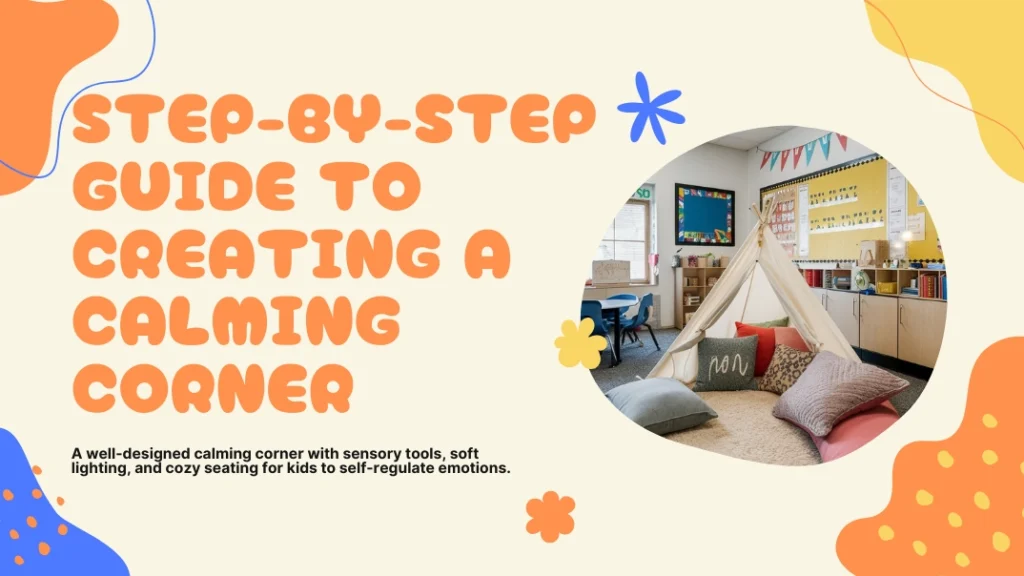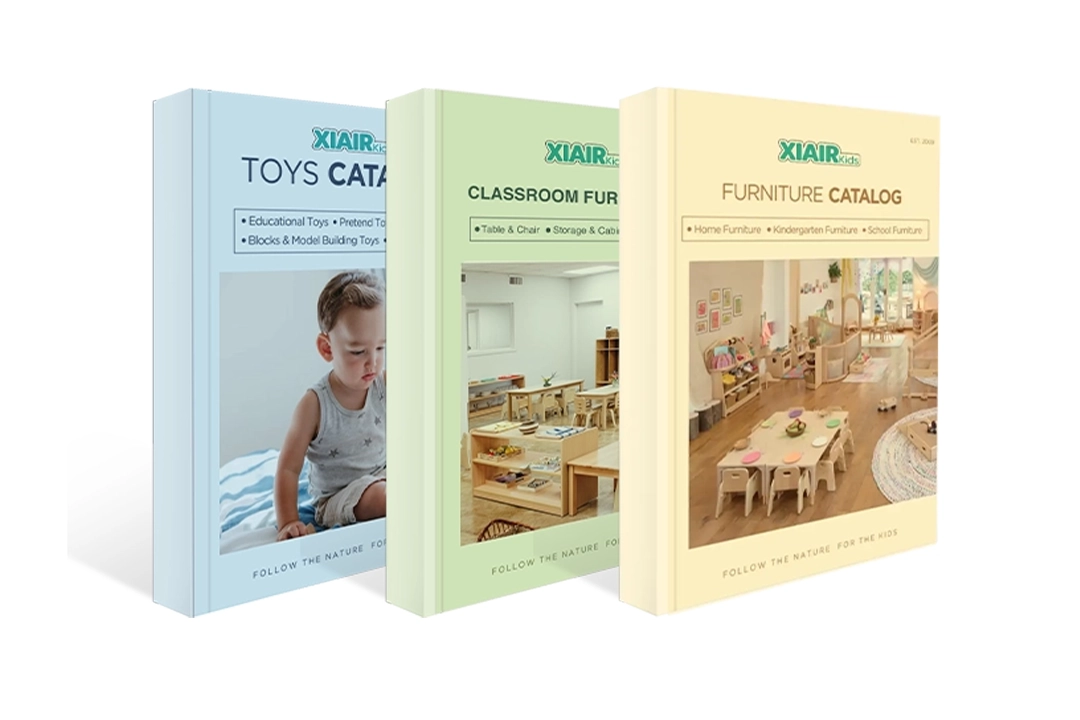Introducción
En el mundo acelerado de hoy, niños de todas las edades, ya sean pequeños en casa o estudiantes en un aula ajetreada, se enfrentan a una estimulación emocional y sensorial abrumadora. Pueden portarse mal, sentirse incomprendidos o tener dificultades para concentrarse sin un espacio seguro donde controlar sus sentimientos. Padres, educadores y terapeutas suelen buscar maneras efectivas de ayudar a los niños a gestionar estas oleadas emocionales. Aquí es donde el concepto de un rincón de calma se convierte en un punto de inflexión.
Un aula donde un estudiante frustrado siente que no tiene escapatoria para calmarse o un hogar donde las rabietas se intensifican porque un niño no tiene las herramientas para calmarse. Sin un sistema estructurado como un rincón de calma, estos momentos pueden descontrolarse, dejando a niños y adultos indefensos. Peor aún, los métodos tradicionales como los "tiempos fuera" a menudo no logran enseñar a los niños la habilidad crucial de la regulación emocional.
Descubre el rincón de la calma: un espacio cuidadosamente diseñado, lleno de herramientas relajantes, objetos sensoriales y recursos visuales que ayudan a los niños a hacer una pausa, procesar y recuperar la compostura. Ya sea un rincón de calma para preescolar, un rincón de calma en el aula o un rincón acogedor en casa, este refugio empodera a los niños para gestionar sus emociones mientras desarrollan su independencia. Desde ideas creativas para rincones de calma hasta configuraciones prácticas con juguetes relajantes y herramientas sensoriales, un rincón de calma bien preparado puede transformar el caos emocional en momentos de aprendizaje.
Crear un rincón de calma fomenta el crecimiento emocional del niño y promueve la armonía en su entorno, ya sea en casa, en la escuela o en terapia. Manténgase al tanto, exploraremos cómo crear y usar un rincón de calma práctico y compartiremos algunas de las mejores ideas para rincones de calma para todas las edades y entornos.

¿Qué es un Rincón de Calma?
Un rincón de calma es un espacio especialmente diseñado para que los niños calmen su mente y cuerpo. En entornos como guarderías o preescolares, donde los niños pequeños suelen experimentar emociones abrumadoras, un rincón de calma es vital para ayudarlos a regular sus sentimientos. A diferencia de un... área de tiempo de esperaUn rincón de calma, que puede resultar punitivo, es una zona de crianza llena de herramientas, elementos visuales y sensoriales que estimulan el crecimiento emocional y las conductas de auto-calma.
La principal diferencia entre un rincón de calma y un tiempo fuera radica en su propósito. Mientras que los tiempos fuera se centran en aislar al niño debido a su comportamiento, un rincón de calma se centra en enseñarle autorregulación. Por ejemplo, en una clase de preescolar, un niño podría usar juguetes antiestrés, pósteres de respiración profunda o una acogedora tienda de campaña en el rincón de calma para relajarse después de una crisis. El objetivo es dotar a los niños de habilidades para toda la vida que les permitan gestionar sus emociones de forma independiente, en lugar de centrarse en el castigo.
¿Quién se beneficia de un rincón de tranquilidad?
Un rincón de calma es especialmente efectivo para niños pequeños en guarderías y preescolares, donde los arrebatos emocionales son comunes debido a un vocabulario limitado y mecanismos de afrontamiento poco desarrollados. Los niños pequeños se benefician de los elementos táctiles y visuales que suelen incluirse en un kit de rincón de calma, como botellas sensoriales, elementos visuales tranquilizadores y objetos con peso. Estas herramientas les brindan consuelo inmediato y les ayudan a pasar de la frustración a la calma.
Por otro lado, los niños en edad preescolar se encuentran en una etapa de desarrollo en la que empiezan a reconocer y etiquetar sus emociones. Un aula con un rincón de calma puede ayudarles a identificar sentimientos como la ira, la tristeza o la frustración, a la vez que les proporciona estrategias para gestionarlas eficazmente. Por ejemplo, recursos visuales como las tablas "Cómo me siento" o los carteles del rincón de calma guían a los niños a identificar sus sentimientos y a elegir una actividad relajante.
Además, los niños con necesidades especiales, como autismo o dificultades de procesamiento sensorial, pueden beneficiarse significativamente de un rincón de calma. En las guarderías, un rincón de calma sensorial, con juguetes sensoriales, alfombras suaves y juguetes sensoriales, puede crear un entorno seguro y predecible para estos niños. Esto ayuda a reducir la sobreestimulación y garantiza que se sientan incluidos y apoyados en el grupo.
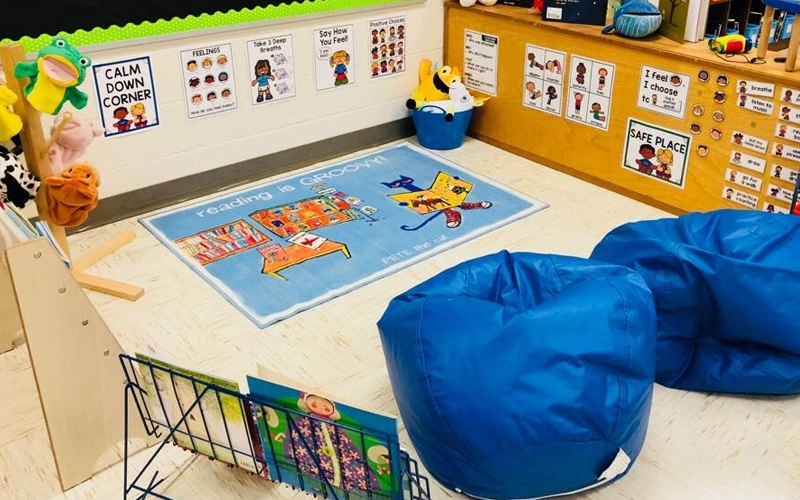
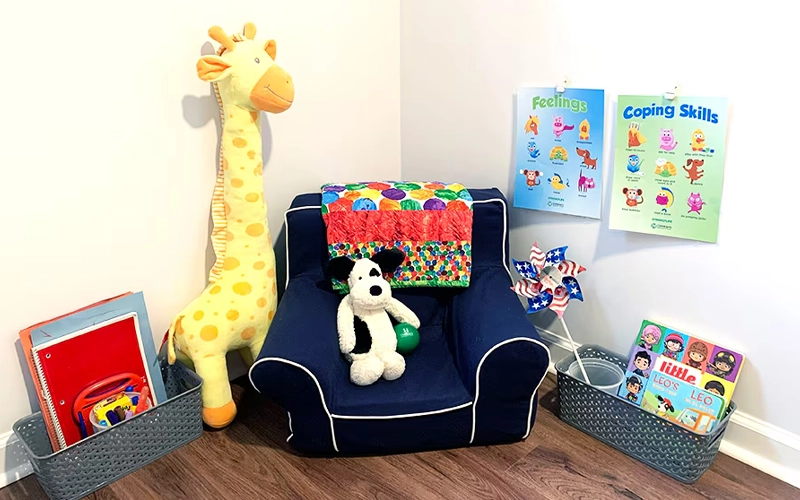
Beneficios de un rincón relajante
Incluir un rincón de tranquilidad en guarderías y centros preescolares ofrece numerosos beneficios para niños y educadores. A continuación, se presentan las ventajas más significativas de incorporar este espacio en los entornos de la primera infancia:
1. Desarrollar habilidades de regulación emocional
Los niños pueden practicar el reconocimiento de sus emociones en un rincón de calma en la guardería y aprender estrategias para gestionarlas. Por ejemplo, un niño que se siente frustrado al no poder completar un rompecabezas podría refugiarse en el rincón de calma y usar botellas sensoriales o ejercicios de respiración para recuperar la concentración. Con el tiempo, estas prácticas repetitivas fortalecen su capacidad de autorregulación, una habilidad esencial para el éxito académico y personal.
2. Ofrecer una salida segura durante momentos estresantes
Para los niños pequeños en preescolar, los arrebatos emocionales son parte normal de su desarrollo. Un rincón de calma preescolar ofrece un espacio seguro donde los niños pueden liberar sus emociones sin temor a ser juzgados. Artículos como una alfombra suave, un puf o una acogedora tienda de campaña crean un ambiente reconfortante que calma sus nervios. Tomar distancia y calmarse empodera a los niños y refuerza las conductas positivas de afrontamiento.
3. Fomentar la conciencia social y la empatía
En un rincón de calma en el aula, los niños aprenden a reconocer sus propias emociones y se vuelven más empáticos con los demás. Por ejemplo, si un compañero usa el rincón de calma, los demás niños aprenden a respetar su espacio y a reconocer la importancia de tomarse un momento para procesar sus sentimientos. Esta comprensión compartida fomenta un ambiente de clase más armonioso.
4. Apoyo a docentes y cuidadores
Gestionar un grupo de niños pequeños o preescolares puede ser abrumador para los educadores. Un aula con un rincón de calma es invaluable, ya que permite a los maestros redirigir a los niños hacia una actividad constructiva durante las crisis emocionales. Esto reduce las interrupciones, facilitando el mantenimiento de un ambiente de aprendizaje productivo y tranquilo. Además, las reglas del rincón de calma, colocadas en el área, ayudan a los niños a comprender las expectativas, minimizando las explicaciones repetitivas de los maestros.
5. Adaptabilidad en distintos entornos
Ya sea en un rincón de calma en la guardería o en casa, esta herramienta es increíblemente versátil. En las aulas de preescolar, los rincones de calma pueden incluir herramientas sensoriales, horarios visuales y pósteres que se adaptan a un entorno grupal. Los padres pueden replicar una configuración similar en casa con artículos como una silla cómoda, juguetes sensoriales o incluso un kit de rincón de calma casero. Esta flexibilidad garantiza que los niños reciban apoyo emocional constante en sus entornos diarios.
6. Promoción de la inclusión de niños con necesidades especiales
Los niños con autismo o sensibilidades sensoriales suelen enfrentar desafíos únicos en entornos grupales. Un rincón de calma preescolar cuidadosamente diseñado puede incluir herramientas sensorialmente amigables, como mantas con peso, auriculares con cancelación de ruido y pelotas antiestrés, para satisfacer sus necesidades. Esto ayuda a estos niños a sentirse seguros y promueve la inclusión, ya que pueden participar más plenamente en las actividades del aula después de calmarse.
7. Fortalecimiento de los vínculos entre padres e hijos y entre docentes y estudiantes
Finalmente, usar un rincón de calma fomenta la confianza entre adultos y niños. Los niños se sienten apoyados y valorados cuando comprenden que tienen un espacio seguro para procesar sus emociones. Esto fomenta relaciones más sólidas, ya sea entre preescolares y sus maestros o entre un niño pequeño y sus padres. Beneficios de un rincón de calma.
Incluir un rincón de tranquilidad en guarderías y centros preescolares ofrece numerosos beneficios para niños y educadores. A continuación, se presentan las ventajas más significativas de incorporar este espacio en los entornos de la primera infancia:
Cómo usar un rincón relajante
Un rincón de calma puede ser una herramienta transformadora en guarderías y preescolares, ayudando a los niños pequeños a gestionar sus emociones eficazmente. Maestros, padres y cuidadores deben guiar a los niños para que comprendan cuándo y cómo usar este espacio y aprovecharlo al máximo. Aquí tienes una guía detallada para asegurar que un rincón de calma se convierta en una parte significativa de la rutina infantil:
1. Comience explicando el propósito
Presente el rincón de la calma como un lugar seguro y acogedor. Para los niños pequeños que asisten a los rincones de la calma en la guardería, explíquelo con palabras como: "Este es un lugar especial donde puedes ir cuando te sientes molesto, enojado o triste. Te ayuda a sentirte mejor". En las aulas de preescolar, los maestros pueden usar carteles o un tablero visual para mostrar qué emociones podrían llevar a un niño a usar el rincón de la calma.
Los padres en casa pueden reforzar esto diciendo: "Tu rincón de la calma está aquí para ayudarte cuando sientas fuertes emociones". Usar frases como "seguro", "tranquilo" y "siéntete mejor" les asegura a los niños que esto no es un castigo, sino una herramienta para el autocuidado.
2. Demuestre cómo utilizar las herramientas
Los artículos de un kit para el rincón de la calma son esenciales para ayudar a los niños a recuperarse. En un rincón de la calma preescolar, estos podrían incluir:
- Botellas sensoriales para calmar visualmente las emociones
- Pelotas antiestrés o juguetes antiestrés para mayor comodidad táctil
- Almohadillas de regazo con peso para la conexión a tierra sensorial
- Carteles con indicaciones de respiración para rincones relajantes
Muestre a los niños cómo usar estas herramientas. Por ejemplo, tome una botella sensorial y diga: "Observen cómo cae la brillantina mientras respiran profundamente". Este tipo de modelado facilita que los niños pequeños comprendan cómo funcionan las herramientas.
3. Fomentar el uso independiente
En las guarderías, los maestros pueden guiar a los estudiantes diciendo: "¿Te gustaría usar el rincón de la calma para sentirte mejor?". Con el tiempo, los niños comenzarán a reconocer sus emociones y se dirigirán al rincón de la calma sin que se les pida.
En casa, los padres pueden crear una rutina similar. Por ejemplo, cuando un niño pequeño esté teniendo una crisis, dígale con cariño: "Vamos a tu rincón de calma y usemos tu pelota blanda para sentirnos mejor". Cuanto más constante sea la práctica, más probable será que los niños usen el rincón de calma por sí solos.
4. Utilice señales visuales para apoyar el aprendizaje
Los recursos visuales son fundamentales para guiar a los niños pequeños. En los rincones de calma del aula, utilice carteles con instrucciones paso a paso como "Respira profundamente tres veces", "Sostén tu peluche" o "Cuenta hasta 10". Acompañe estos pasos con imágenes o clipart para reconocerlos fácilmente.
Las ayudas visuales, como las tablas de emociones o los letreros de esquinas tranquilas, ayudan a los niños pequeños a identificar sus sentimientos. Estas herramientas hacen que el proceso sea atractivo e interactivo, garantizando que incluso los niños que no hablan puedan participar.
5. Adaptar el espacio a diferentes necesidades
Un rincón de calma sensorial puede satisfacer diversas necesidades. Para niños con autismo o dificultades de procesamiento sensorial en guarderías, los rincones relajantes incluyen auriculares con cancelación de ruido, mantas con textura o luces relajantes. En las aulas de preescolar, una carpa acogedora y relajante con almohadas y alfombras suaves puede crear un ambiente de refugio que los haga sentir seguros.
6. Intégralo en la rutina diaria
Para que el rincón de la calma sea parte natural del día de un niño, inclúyalo en sus actividades diarias. Por ejemplo, después de una actividad grupal emocionante, sugiera: "Tomemos un momento en el rincón de la calma para relajarnos". Esto normaliza su uso y reduce el estigma que pueda sentir el niño.
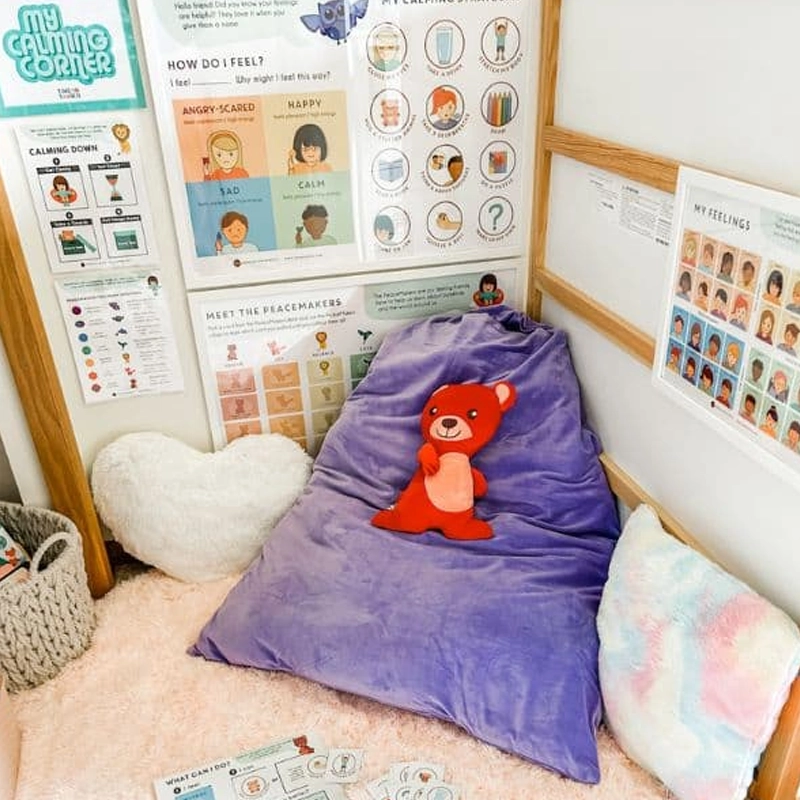
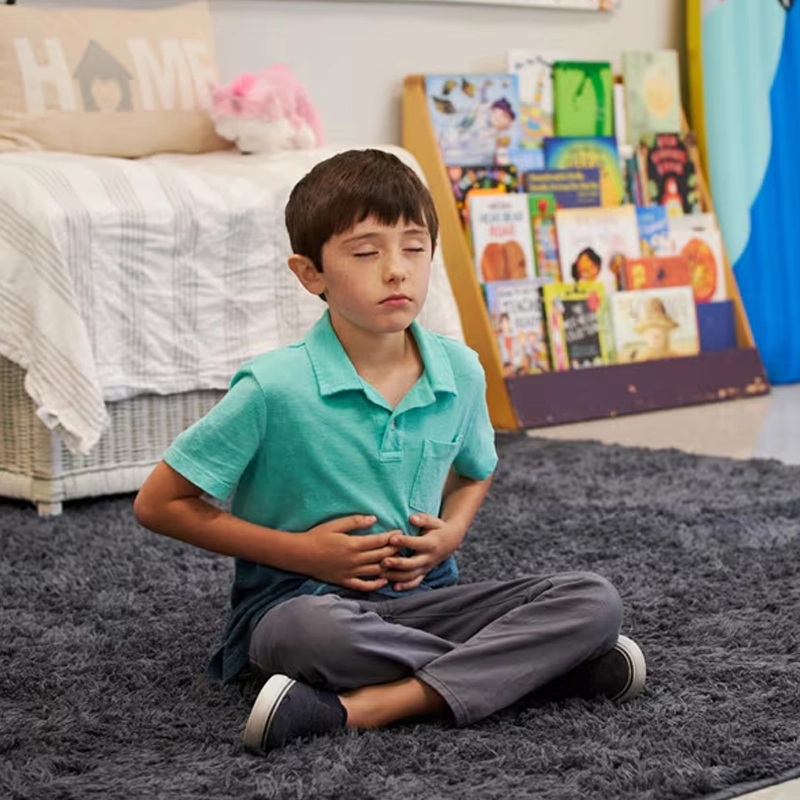
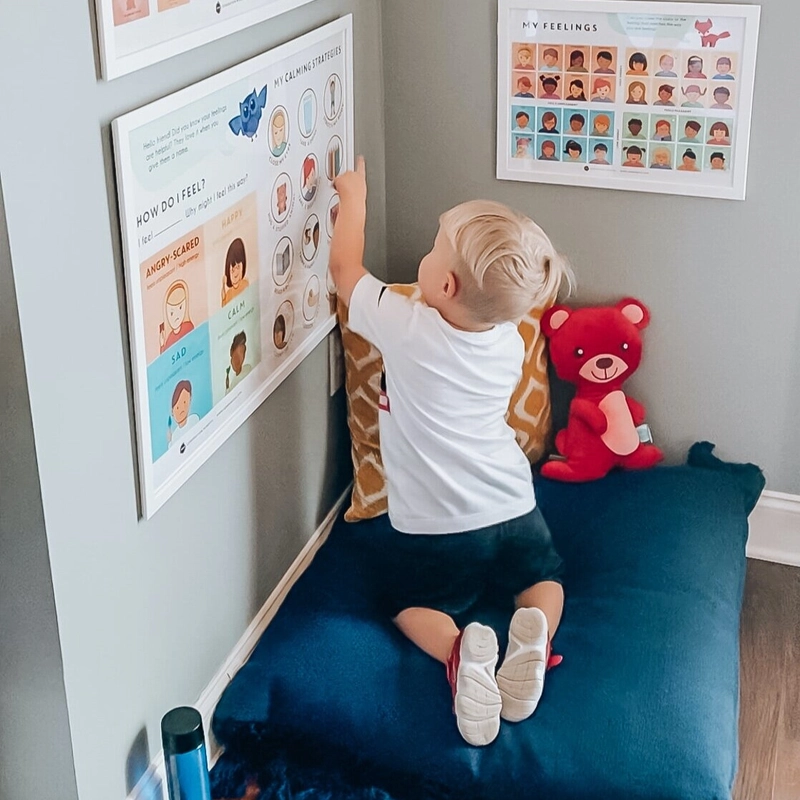
Reglas del rincón de la calma
Establecer reglas claras y sencillas es esencial para garantizar que el rincón de la calma se use eficazmente. Estas reglas ayudan a los niños a comprender cómo respetar el espacio mientras lo usan para tranquilizarse.
1. Mantenga las reglas simples y positivas
Los niños pequeños en los rincones de tranquilidad del preescolar necesitan pautas fáciles de seguir. Algunos ejemplos de reglas eficaces incluyen:
- “Utilice voces tranquilas en el rincón tranquilo”.
- “Sólo un niño a la vez.”
- “Utilice las herramientas con cuidado”.
Colocar estas reglas en un póster de expectativas para el rincón de la calma garantiza que siempre estén visibles. Combina el texto con imágenes prediseñadas o imágenes para que las reglas sean más accesibles para niños pequeños y preescolares.
2. Reforzar el propósito del espacio
Los niños deben entender por qué existen las reglas. Por ejemplo, los maestros pueden decir en el rincón de la calma del aula: «Estas reglas ayudan a que el rincón de la calma sea un lugar seguro para todos». En casa, los padres podrían explicar: «El rincón de la calma es para calmar el cuerpo y la mente, no para jugar ni pelear».
3. Utilice ayudas visuales para reforzar la comprensión
Un cuadro visual con iconos en los rincones relajantes de la guardería puede ilustrar su uso adecuado. Por ejemplo, la imagen de un niño sentado tranquilamente o con una pelota antiestrés puede mostrar comportamientos aceptables. Utilice imágenes brillantes, atractivas y relajantes para los rincones, a fin de que el espacio sea atractivo y educativo.
4. Ajuste las reglas según el entorno
Las reglas para un rincón de calma preescolar podrían incluir recordatorios para compartir herramientas o esperar su turno. En una guardería, la prioridad podría ser la seguridad, como evitar tirar o usar mal los objetos. Considere adaptar las reglas para niños con necesidades especiales e incluir pautas sensoriales adicionales.
5. Reforzar las reglas mediante retroalimentación positiva
Celebre cuando los niños usen correctamente el rincón de la calma. Un maestro podría decir: "¡Hiciste un excelente trabajo calmándote y siguiendo las reglas!". El refuerzo positivo ayuda a los niños a sentirse orgullosos de su progreso y los anima a usar el espacio adecuadamente.
6. Fomentar la propiedad del espacio
Involucre a los niños en el mantenimiento del rincón de la calma. Por ejemplo, permítales ayudar a organizar las herramientas o decorarlo con decoraciones como pósteres o pancartas. Este sentido de pertenencia los hace más propensos a respetar las reglas y a usar el espacio con cuidado.
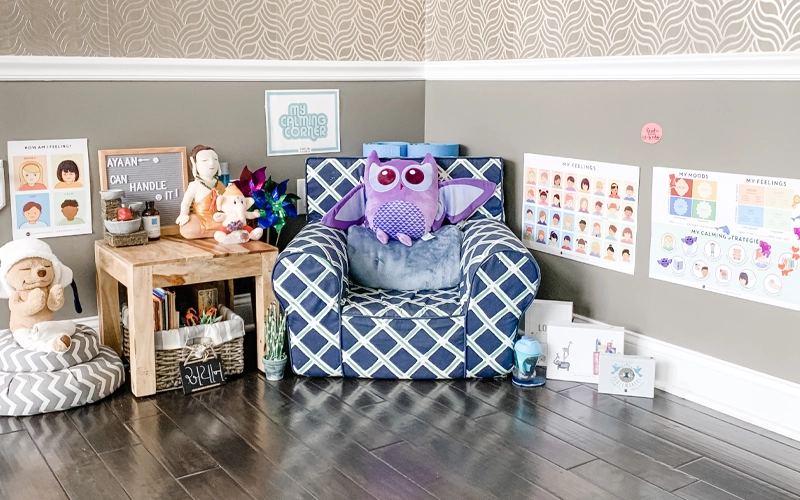
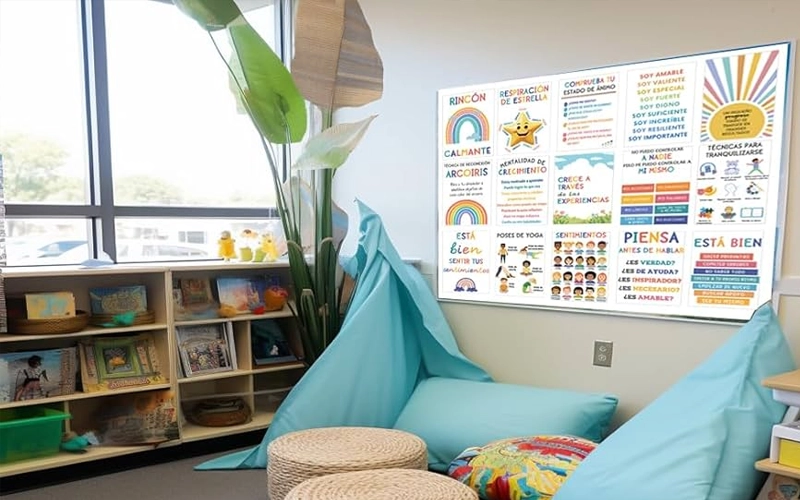
Cómo crear un rincón relajante
Un rincón de calma bien diseñado es una herramienta poderosa para ayudar a los niños a gestionar sus emociones y, al mismo tiempo, fomentar la autorregulación. Ya sea en casa o en el aula, un rincón de calma proporciona un espacio seguro y reconfortante para que los niños procesen sus sentimientos, recuperen la concentración y practiquen estrategias de afrontamiento. A continuación, encontrará una guía detallada para crear un rincón de calma ideal para el hogar y la escuela.
Rincón de calma en casa
Crear un rincón de calma en casa permite a los niños gestionar las fluctuaciones emocionales diarias en un entorno familiar y cómodo. Un rincón de calma en casa debe reflejar las necesidades únicas del niño y ofrecer un espacio estable para desescalar los momentos estresantes.
Elegir la ubicación adecuada
El primer paso para crear un rincón tranquilo en casa es seleccionar un lugar adecuado que sea accesible y tranquilo.
- Elige un lugar tranquiloElija una zona poco transitada, como un rincón de la sala, el dormitorio o la sala de juegos. Evite lugares con mucho ruido, como cerca del televisor o la cocina.
- Crear privacidadUse un pequeño separador, una cortina o una carpa para un rincón tranquilo para brindarle al niño una sensación de seguridad y privacidad. Por ejemplo, colocarla cerca de una ventana con luz natural puede ayudar a crear un ambiente relajante.
- Garantizar la accesibilidad:El espacio debe ser fácil de encontrar y alcanzar para el niño de forma independiente cuando lo necesite.
Si el espacio es limitado, puedes designar un área pequeña con una alfombra suave y un cartel relajante, convirtiendo incluso el rincón más pequeño en un rincón de calma efectivo.
Amueblando el rincón de la calma
Para que el espacio sea acogedor y funcional, incluya muebles y decoración que fomenten la comodidad y la relajación:
- Asientos blandos:Utilice un sillón puf, un taburete acolchado o cojines en el suelo como un lugar acogedor donde los niños puedan sentarse y relajarse.
- Alfombras y mantas:Una alfombra suave o una manta con peso pueden proporcionar una base sensorial para el niño.
- Elementos decorativos:Agregue elementos visuales relajantes como arte de pared relajante, luces de hadas o calcomanías con temas de la naturaleza para crear un ambiente tranquilo.
- Tienda de campaña de esquina relajante:Una pequeña carpa o toldo puede brindarle al rincón una sensación acogedora y privada que es especialmente beneficiosa para los niños sensibles a los sentidos.
Almacenamiento de herramientas y juguetes esenciales
Las herramientas que proporciones en un rincón de calma deben satisfacer las necesidades sensoriales y fomentar la regulación emocional. Aquí tienes algunas ideas:
- Botellas sensoriales:Son excelentes para atraer la atención de los niños y ayudarlos a concentrarse mientras observan el brillo o los objetos que se mueven lentamente dentro de la botella.
- Pelotas antiestrés y juguetes antiestrés:Las herramientas táctiles permiten a los niños liberar la energía acumulada de forma segura.
- Artículos ponderados:Incluya una manta con peso o una almohadilla para el regazo de los niños que encuentran relajante la presión profunda.
- Gráficos de emociones:Ayude a los niños a identificar y etiquetar sus sentimientos, como la ira, la tristeza o la frustración.
- Carteles de respiración:Las guías visuales para ejercicios de respiración profunda pueden enseñar a los niños a calmarse paso a paso.
- Artículos de confort favoritos:Agregue un animal de peluche, un libro favorito o un juguete pequeño que ayude al niño a sentirse seguro.
Ideas DIY para un rincón relajante personalizado
La incorporación de elementos DIY añade un toque personal al rincón de tranquilidad, haciéndolo aún más especial para tu hijo:
- Frascos sensoriales:Use agua, brillantina y colorante de alimentos para crear frascos con brillantina.
- Obra de arte personalizada:Involucra a tu hijo en la decoración del espacio con dibujos, manualidades o fotografías familiares.
- Caja de herramientas personalizada:Utilice una pequeña canasta o caja para guardar herramientas sensoriales y anime a su hijo a organizarlas.
¡No solo lo sueñes, diséñalo! ¡Hablemos sobre tus necesidades de muebles personalizados!
Rincón de calma en las aulas
En las aulas de preescolar y las guarderías, un rincón de calma es un recurso invaluable tanto para profesores como para alumnos. Ofrece un espacio compartido donde los niños pueden regular sus emociones y, al mismo tiempo, fomentar la armonía en el aula.
Seleccionar el lugar correcto
- Ubicación accesible:Coloque el rincón de tranquilidad en un área visible del aula que aún esté algo alejada de las zonas de alto tráfico.
- Minimizar las distracciones:Mantenga la esquina alejada de áreas ruidosas como la zona de juegos o las mesas de actividades grupales.
- Mantener la supervisión de los docentes:Asegúrese de que el espacio sea lo suficientemente visible para que los maestros puedan supervisar su uso y, al mismo tiempo, brindarles a los niños una sensación de privacidad.
Adición de elementos visuales y señalización
Las señales visuales son esenciales para que los niños pequeños comprendan y se involucren en el rincón de calma:
- Carteles de rincones relajantes:Muestre instrucciones paso a paso sobre cómo usar el espacio, como “Respire profundamente”, “Sostenga un juguete antiestrés” o “Conte hasta 10”.
- Gráficos de emociones:Incluya un cuadro de sentimientos para ayudar a los niños a reconocer sus emociones y elegir una actividad relajante.
- Póster de reglas:Un cartel de expectativas para el rincón de la calma describe pautas simples, como “Usar voces suaves” y “Tomar turnos”.
Almacenamiento de herramientas sensoriales y calmantes
Equipe el rincón de tranquilidad del aula con herramientas que satisfagan una amplia gama de necesidades:
- Auriculares con cancelación de ruido:Ayude a los niños a reducir la sobrecarga sensorial en aulas ruidosas.
- Almohadillas de regazo con peso:Proporcione presión calmante para los niños que necesitan estimulación sensorial.
- Temporizadores de arena:Enseñe a los niños cómo administrar el tiempo y al mismo tiempo ayudarlos a concentrarse durante su descanso relajante.
- Libros de cuentos o libros ilustrados: Elija libros tranquilizadores y visualmente atractivos para redirigir la atención de los niños.
- Temporizadores visuales:Muestre a los niños cuánto tiempo tienen para pasar en la esquina, promoviendo un descanso estructurado.
Orientando a los estudiantes en el uso del espacio
Los profesores desempeñan un papel crucial a la hora de introducir y modelar el uso de un rincón de calma en el aula:
- Presentar el espacio:Explique a los estudiantes que el rincón de calma es un lugar seguro para tomar un descanso y sentirse mejor.
- Uso del modelo:Muestre cómo utilizar las herramientas, como apretar una pelota antiestrés o concentrarse en una botella sensorial.
- Proporcionar indicaciones suaves:Cuando un niño esté molesto, dígale: "¿Te gustaría usar el rincón de la calma para sentirte mejor?"
| Herramienta | Objetivo | Mejor escenario de uso |
|---|---|---|
| Juguetes para hacer estallar burbujas | Proporciona estimulación táctil para liberar energía nerviosa. | Ideal para rincones tranquilos para niños pequeños en edad preescolar. |
| Difusores de aceites esenciales | Emite aromas calmantes como lavanda para crear una atmósfera relajante. | Ideal para rincones relajantes del hogar. |
| Tejidos de vellón suave | Ofrece una respuesta táctil reconfortante para reducir la ansiedad. | Útil para niños sensoriales sensibles. |
| Reproductores de música silenciosos | Reproduce sonidos de fondo suaves (por ejemplo, naturaleza, ruido blanco) para calmar la mente. | Perfecto para rincones tranquilos de guardería. |
| Gráficos de emociones colaborativos | Fomenta debates grupales sobre emociones y soluciones. | Adecuado para rincones tranquilos en el aula. |
| Almohadillas de regazo con peso | Proporciona una entrada sensorial de presión profunda para la conexión a tierra. | Eficaz tanto en el aula como en el hogar. |
| Herramientas para jugar con arena | Permite que los niños se concentren en movimientos repetitivos y calmantes. | Beneficioso en rincones de calma sensorial. |
| Temporizadores visuales | Ayuda a los niños a comprender y gestionar el tiempo de calma. | Esencial para rincones de clase estructurados |
¡Tu aula perfecta está a un clic de distancia!
Mejores prácticas tanto para el hogar como para el aula
Crear y mantener un rincón tranquilo y próspero requiere una implementación cuidadosa y una gestión constante. Aquí tienes una lista ampliada de buenas prácticas para crear rincones tranquilos en casa y en el aula, garantizando que sigan siendo eficaces y atractivos para niños de todas las edades.
Mantenga las herramientas organizadas
Un rincón organizado y tranquilo permite que los niños accedan fácilmente a las herramientas necesarias sin sentirse abrumados.
- Etiqueta todoUse contenedores, cestas o recipientes transparentes etiquetados con palabras o imágenes (p. ej., "Juguetes antiestrés", "Libros", "Herramientas de respiración"). Esto es especialmente útil para niños en edad preescolar que aún no saben leer.
- Crear secciones:Divide el espacio en áreas para herramientas específicas: elementos sensoriales en una canasta, ayudas visuales en la pared y juguetes de peluche en un estante.
- Herramientas de rotaciónPara mantener el rincón fresco y atractivo, intercambie periódicamente herramientas o juguetes según las estaciones, los temas o los intereses del niño. Por ejemplo, añada una botella sensorial con forma de copo de nieve en invierno o elementos visuales con temática oceánica en verano.
- Utilice opciones portátiles:Para espacios pequeños o aulas con espacio limitado, considere kits de calma portátiles o cajas de herramientas que los niños puedan llevar a sus escritorios o a un rincón tranquilo.
Adaptarse a la edad y las necesidades
Un rincón próspero y tranquilo debe crecer con el niño, atendiendo a su etapa de desarrollo y necesidades únicas.
- Para niños pequeños:
- Concéntrese en herramientas simples y táctiles, como animales de peluche, pelotas sensoriales y telas suaves.
- Utilice ayudas visuales como cuadros de emociones “¿Cómo me siento?” con caras en lugar de palabras.
- Incluya elementos que promuevan la familiaridad, como una manta o un juguete favorito.
- Para niños en edad preescolar:
- Agregue herramientas estructuradas como temporizadores visuales, guías de respiración o rompecabezas simples.
- Fomente la independencia permitiendo que los niños elijan sus herramientas en función de sus emociones.
- Introduzca pequeños desafíos, como combinar las emociones con estrategias calmantes apropiadas.
- Para niños con necesidades especiales:
- Se ofrecen artículos sensoriales especiales como mantas con peso, auriculares con cancelación de ruido o juguetes texturizados.
- Utilice cronómetros o cronómetros visuales individualizados para ayudarlos a comprender cuánto tiempo deben usar el espacio.
- Evite las imágenes sobreestimulantes y priorice colores neutros y calmantes en la configuración.
Fomentar la propiedad
Cuando los niños mantienen y personalizan el rincón de tranquilidad, es más probable que lo respeten y lo utilicen de manera efectiva.
- Involucre a los niños en el diseñoPide a los niños que elijan colores, decoraciones o herramientas específicas para su rincón de la calma. Por ejemplo, deja que elijan sus botellas sensoriales favoritas o diseñen carteles con afirmaciones relajantes.
- Enseñar responsabilidad:Muestre a los niños cómo volver a colocar las herramientas en sus lugares designados y cuidar elementos como juguetes antiestrés o libros.
- Hazlo interactivo:Agregue un buzón de sugerencias o un tablero de comentarios donde los niños puedan solicitar nuevas herramientas o cambios en el espacio.
- Celebrar el usoRefuerce el comportamiento positivo reconociendo el uso adecuado del rincón. Por ejemplo, "¡Me di cuenta de que fuiste al rincón de la calma cuando te sentías molesto! ¡Fue una excelente decisión!".
Crea un ambiente acogedor
El entorno de un rincón relajante juega un papel importante en su efectividad.
- Elija colores calmantesOpta por tonos neutros, pasteles o suaves como el azul claro, el verde o el lavanda. Estos colores son conocidos por promover la relajación.
- Incorporar la naturaleza:Utilice elementos como plantas pequeñas, carteles de naturaleza o temas relajantes del océano o del bosque para crear un ambiente relajante.
- Añadir iluminación suave:Utilice luces de colores, velas LED o lámparas regulables para evitar una iluminación intensa desde arriba.
- Garantizar la comodidad:Ofrecemos opciones de asientos que se adapten a diferentes preferencias, como pufs, colchonetas o mecedoras.
Establecer reglas consistentes
Las reglas garantizan que todos los niños utilicen el rincón de calma de forma respetuosa y eficaz.
- Reglas claras y sencillas:Utilice frases cortas como “Un niño a la vez”, “Use voces suaves” y “Devuelva las herramientas cuando haya terminado”.
- Pósteres de reglas visuales:Muestre las reglas en la esquina usando íconos o imágenes para que sean accesibles incluso para los niños pequeños.
- Reforzar las reglas mediante la prácticaRepresenta situaciones comunes con los niños para mostrarles cómo seguir las reglas. Por ejemplo, muéstrales cómo respetar los turnos o usar las herramientas con cuidado.
- Adaptar las reglas para el uso grupal: Añada reglas sobre compartir y esperar turno en las aulas. En casa, céntrese en el uso individual y el respeto por el espacio.
Estructura de equilibrio y flexibilidad
Si bien las reglas y las rutinas son esenciales, el rincón de calma debe sentirse como un espacio seguro y sin restricciones.
- Permitir la libre elección:Deje que los niños decidan cuándo utilizar el espacio y con qué herramientas interactuar.
- Evite programar demasiado:En lugar de hacer de la esquina una rutina rígida, fomente el uso orgánico en función de las necesidades de los niños.
- Sea flexible con los límites de tiempo:Utilice cronómetros visuales como guía, pero permita que los niños extiendan su tiempo si es necesario.
Evaluar y actualizar periódicamente el espacio
Las necesidades y preferencias de los niños evolucionan, por lo que mantener el rincón de tranquilidad relevante es esencial.
- Observar patrones de usoToma nota de las herramientas más populares y las que se usan con menos frecuencia. Reemplaza las que no uses por alternativas que puedan funcionar mejor.
- Solicitar retroalimentaciónConsulte periódicamente con los niños para preguntarles: "¿Qué te gusta del rincón de tranquilidad?" o "¿Qué lo haría mejor para ti?"
- Actualizaciones de temporada:Agregue elementos con temática estacional o festiva, como hojas de otoño o copos de nieve de invierno, para mantener el espacio fresco y emocionante.
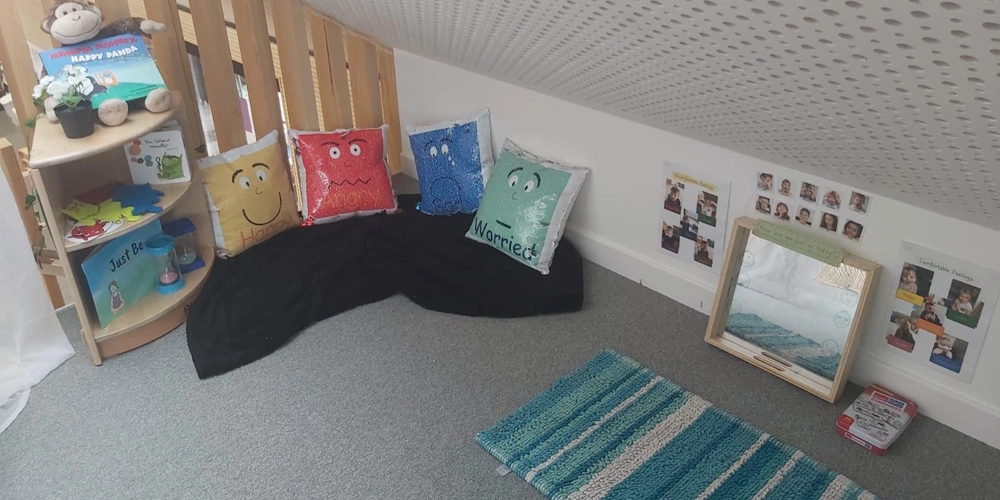
¿Para qué edad es adecuado un rincón de calma?
Un rincón de calma es una herramienta versátil que se adapta a niños de diferentes edades, desde niños pequeños hasta estudiantes de primaria. Al adaptar el diseño y las herramientas a la etapa de desarrollo del niño, un rincón de calma puede satisfacer las necesidades emocionales y sensoriales de cualquier edad. A continuación, se detalla cómo funcionan los rincones de calma para diferentes edades.
Rincones relajantes para niños pequeños
Los niños pequeños (de 1 a 3 años) están comenzando a desarrollar conciencia emocional y habilidades de autorregulación, lo que hace que un rincón tranquilo para ellos sea un recurso invaluable.
- Por qué se benefician los niños pequeñosLos niños suelen experimentar emociones intensas, como frustración o sobreestimulación, pero carecen del lenguaje para expresarlas en esta etapa. Un rincón tranquilo para niños pequeños les ofrece un espacio seguro para procesar estas emociones.
- Herramientas para niños pequeños:
- Botellas sensorialesLos niños pequeños se sienten atraídos visualmente por el brillo o los pequeños objetos que se mueven dentro de botellas sensoriales, lo que los ayuda a concentrarse y calmarse.
- Peluches o mantasLos objetos familiares y reconfortantes crean una sensación de seguridad.
- Tarjetas de emociones:Utilice gráficos de emociones simples basados en imágenes para ayudar a los niños pequeños a identificar sentimientos como "feliz" o "triste".
- Consejos de diseñoMantenga el espacio pequeño, acogedor y accesible. Use alfombras o tapetes suaves para crear un límite, de modo que los niños pequeños puedan reconocer y evitar objetos con piezas pequeñas que podrían representar un peligro de asfixia.
Rincones de calma para preescolares
Los niños en edad preescolar (de 3 a 5 años) se encuentran en una etapa en la que empiezan a comprender sus emociones y a aprender estrategias de afrontamiento. Un rincón de calma preescolar puede ayudarles a practicar estas habilidades de forma estructurada.
- ¿Por qué se benefician los niños en edad preescolar?Los niños en edad preescolar suelen experimentar frustración en entornos grupales, como compartir juguetes o seguir las reglas del aula. Un rincón de calma preescolar les permite desconectar, reorganizarse y retomar la actividad con mayor claridad.
- Herramientas para niños en edad preescolar:
- Carteles de respiración:Las indicaciones visuales guían a los niños a través de ejercicios de respiración profunda para regular las emociones.
- Juguetes antiestrés:Artículos como pelotas antiestrés o juguetes pop-it brindan a los niños en edad preescolar una salida táctil para la energía nerviosa.
- Auriculares con cancelación de ruido:Estos ayudan a reducir la sobrecarga sensorial en aulas o salas de juegos concurridas.
- Consejos de diseñoIncorpora carteles coloridos y relajantes para rincones y crea un ambiente acogedor con asientos cómodos, como pufs o sillones pequeños. Usa elementos visuales para reforzar el propósito del rincón, como "Este es tu espacio de tranquilidad para sentirte mejor".
Rincones de calma para estudiantes de primaria
Para los niños de la escuela primaria (de 6 a 10 años), los rincones de calma se convierten más en una forma de fomentar la independencia en la regulación emocional.
- ¿Por qué se benefician los estudiantes de primaria?Los niños mayores suelen lidiar con las relaciones con sus compañeros, el estrés académico y emociones complejas. Un rincón de tranquilidad en el aula les ofrece un espacio tranquilo para descomprimirse y reflexionar sobre sí mismos sin sentirse señalados.
- Herramientas para estudiantes de primaria:
- Diarios o blocs de notas:Anime a los estudiantes a escribir sobre sus sentimientos o utilice indicaciones como "¿Qué te molestó?"
- Temporizadores de arena:Ayude a los estudiantes a comprender cuánto tiempo deben pasar en el rincón de tranquilidad.
- Almohadillas de regazo con peso:Ofrecer apoyo sensorial a los niños que necesitan estabilidad durante los momentos emocionales.
- Consejos de diseñoCree un espacio inclusivo añadiendo libros sobre emociones, herramientas interactivas como rompecabezas o actividades colaborativas para uso en grupo. Incluya un cronómetro visual para ayudar a los estudiantes a gestionar responsablemente su tiempo en el rincón.
Rincones de tranquilidad para niños con necesidades especiales
Los niños con necesidades especiales, como autismo o TDAH, a menudo se benefician significativamente de un rincón de relajación sensorial bien diseñado y adaptado a sus desafíos específicos.
- ¿Por qué se benefician los niños con necesidades especiales?Estos niños pueden sufrir una sobrecarga sensorial o dificultades para procesar sus emociones, lo que hace que un rincón de calma sea una herramienta esencial para la autorregulación.
- Herramientas para necesidades especiales:
- Auriculares con cancelación de ruido:Bloquea sonidos abrumadores en entornos concurridos.
- Artículos sensoriales táctiles:Incluya juguetes antiestrés con textura, arena cinética o muestras de telas suaves para una interacción táctil.
- Mantas o chalecos con peso:Proporciona estimulación de presión profunda para calmar el sistema nervioso.
- Consejos de diseñoUse colores tenues y limite el desorden visual para crear un ambiente relajante. Asegúrese de que el rincón tenga límites claros y herramientas predecibles para sentirse seguro y confiable.
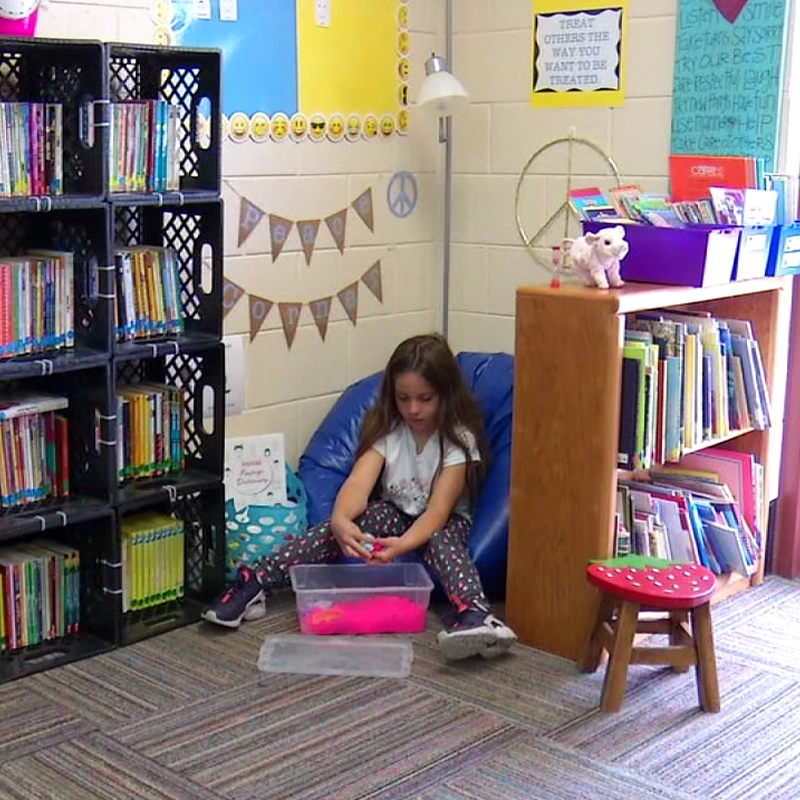
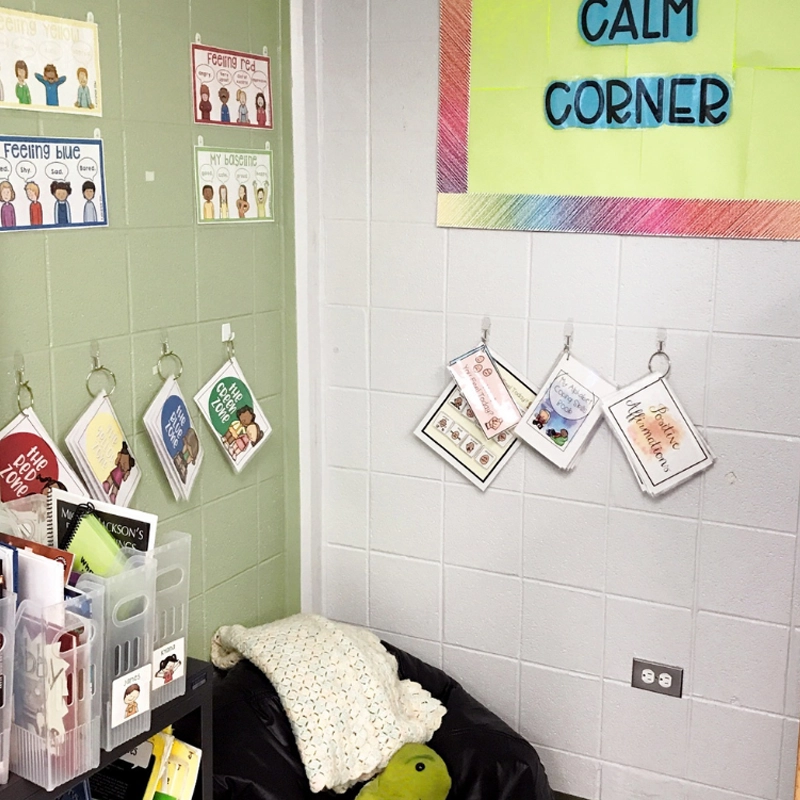
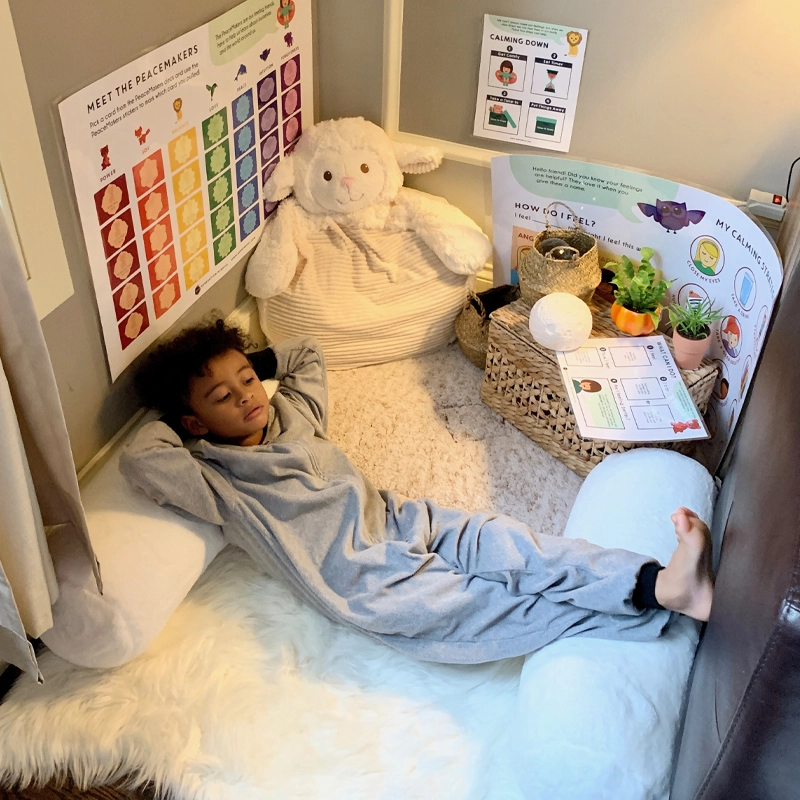
Elementos esenciales para un rincón relajante
El éxito de un rincón de calma depende en gran medida de las herramientas y recursos que se proporcionen. Cada elemento debe tener una función: calmar los sentidos, estimular la mente o enseñar técnicas de autorregulación. A continuación, se presenta una lista completa de elementos esenciales para un rincón de calma, adaptados a diferentes necesidades y entornos.
Herramientas y recursos imprescindibles
Cada rincón de tranquilidad debe incluir herramientas esenciales que satisfagan las necesidades sensoriales y emocionales del niño:
- Juguetes calmantes:Para estimulación táctil y visual, pelotas antiestrés, fidget spinners y botellas sensoriales.
- Carteles y guías:Incluya carteles de rincones relajantes con instrucciones para ejercicios de respiración o técnicas de regulación de emociones.
- Artículos ponderados:Mantas con peso o almohadillas para el regazo para niños que se benefician de un aporte de presión profunda.
Herramientas centradas en los sentidos
Las herramientas sensoriales son vitales para ayudar a los niños a redirigir su atención y recuperar el control de sus emociones:
- Auriculares con cancelación de ruido:Bloquee los sonidos abrumadores en aulas o guarderías ruidosas.
- Juguetes para hacer estallar burbujas:Proporcione una actividad repetitiva y relajante en la que los niños puedan concentrarse.
- Arena cinética o plastilina:Ofrezca interacción táctil para liberar el estrés a través del tacto.
Elementos decorativos y funcionales
El entorno de un rincón relajante juega un papel fundamental en su eficacia:
- Alfombras o tapetes suaves:Define el espacio y hazlo físicamente acogedor.
- Asientos cómodos:Utilice pufs, sillas pequeñas o taburetes acolchados para estimular la relajación.
- Iluminación suave:Agregue luces de hadas o lámparas regulables para crear un ambiente relajante.
Materiales adaptados para el hogar y el aula
Las herramientas y el diseño deben reflejar el entorno específico:
- Para el hogar:Incluya elementos de consuelo personal, como animales de peluche favoritos, mantas o fotografías familiares.
- Para las aulas:Concéntrese en herramientas compartidas, como relojes de arena o cuadros de emociones grupales, manteniendo al mismo tiempo reglas claras para tomar turnos.
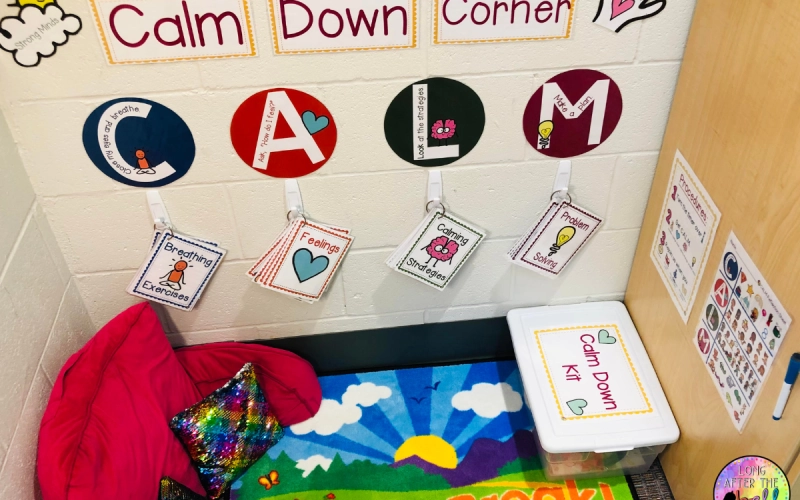
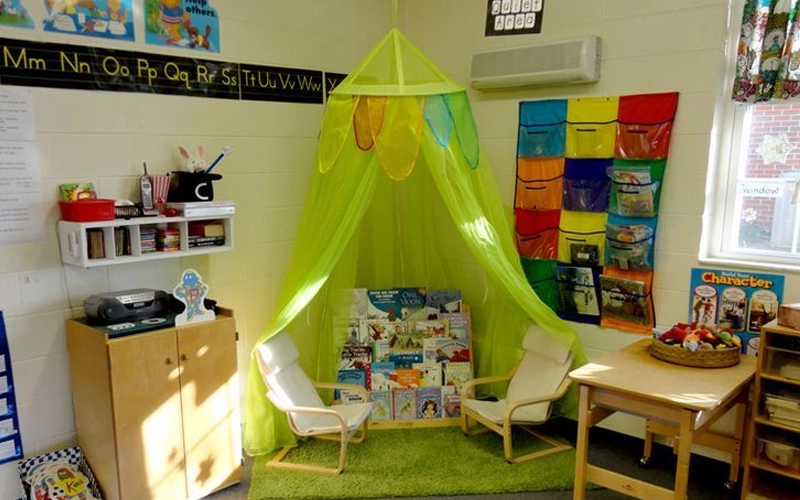
Ideas creativas para diseñar un rincón relajante
Diseñar un rincón de calma puede ser un proceso divertido y creativo, que permite personalizar el espacio según las necesidades y preferencias de los niños que lo usarán. Desde ideas DIY económicas hasta configuraciones temáticas que estimulan la imaginación, un rincón de calma bien diseñado puede marcar la diferencia en su eficacia para promover la regulación emocional. A continuación, se presentan algunas ideas creativas para rincones de calma en casa y en el aula, que incorporan consejos, herramientas y elementos prácticos.
Ideas para rincones relajantes en casa: un espacio acogedor y atractivo
Un rincón tranquilo en casa puede ser un santuario cálido y personalizado donde los niños se sienten seguros y apoyados. Aquí te explicamos cómo hacerlo único:
- Elige un tema:
- Crea un rincón de tranquilidad inspirado en la naturaleza con plantas, una pequeña fuente en cascada y tonos terrosos.
- Pruebe un tema de “Explorador espacial” con estrellas que brillan en la oscuridad, luces suaves de galaxia y una carpa con forma de cohete.
- Incorporar características sensoriales:
- Agregue una alfombra suave y peluda o un tapete de espuma para definir el área y brindar un lugar cómodo para sentarse.
- Utilice una manta con peso o almohadas de felpa con diferentes texturas para mayor comodidad sensorial.
- Cuelgue una pequeña hamaca o un columpio para los niños que encuentran relajante el balanceo suave.
- Hazlo personal:
- Incluya una “Caja de sentimientos” donde los niños puedan colocar notas o dibujos sobre sus emociones.
- Deje que su hijo decore el espacio con sus carteles de rincones relajantes favoritos o fotografías de lugares relajantes, como la playa o un bosque.
- Agregue un proyecto de bricolaje “Frasco de la calma” que su hijo puede crear y personalizar.
- Ejemplo de configuración:
- Utilice luces de cadena con forma de estrellas para una iluminación suave.
- Agregue un pequeño estante para guardar botellas sensoriales, juguetes antiestrés y un juego de tarjetas de emociones.
- Coloque un cojín de piso suave y redondo o un sillón puf para sentarse cómodamente mientras utiliza las herramientas.
Inspiración para un rincón relajante en el aula
Un rincón de relajación bien diseñado puede proporcionar un espacio de descanso muy necesario para los alumnos de preescolar o guardería. La creatividad puede hacer que el espacio no solo sea funcional, sino también atractivo y divertido.
- Rincones relajantes temáticos:
- Tema de adentro hacia afuera:Utilice Disney De adentro hacia afuera Personajes para ayudar a los niños a identificar emociones. Asocia cada personaje con herramientas o actividades, como Alegría para una botella sensorial, Tristeza para una manta suave y Enojo para una pelota antiestrés.
- Bajo el mar:Decora el espacio con imágenes de temática oceánica, como peces y corales, e incluye elementos en tonos azules como una botella de agua relajante o una máquina de sonido del océano.
- Retiro en la jungla:Agregue plantas falsas, juguetes antiestrés con temática de animales y sonidos relajantes de la naturaleza para una experiencia sensorial inmersiva.
- Muros interactivos:
- Utilice tableros magnéticos con imanes de emociones que los niños puedan mover para expresar sus sentimientos.
- Instale un cartel de “Ruta de los sentimientos”, que guía a los estudiantes a través de pasos para calmarse usando imágenes y sugerencias.
- Espacios colaborativos:
- Incluya herramientas grupales como rompecabezas, juegos de mesa simples o cuadros de emociones colaborativos que permitan que dos niños usen el espacio juntos.
- Agregue divisores suaves para que los niños tengan la opción de privacidad o uso compartido.
Uso de imágenes prediseñadas, pancartas o letreros para añadir encanto
Elementos decorativos como imágenes prediseñadas, pancartas y letreros relajantes para rincones pueden mejorar el espacio, haciéndolo más atractivo visualmente y funcional:
- Imágenes prediseñadas y carteles:
- Utilice imágenes prediseñadas coloridas y apropiadas para la edad del rincón de la calma para mostrarles a los niños cómo usar las herramientas. Por ejemplo, muestre ejercicios de respiración paso a paso o estrategias de calma.
- Crea carteles con frases como “Respira profundo” o “Siente tus sentimientos” para reforzar el propósito del rincón.
- Banners y etiquetas:
- Cuelgue una pancarta sobre el espacio con las palabras “Zona tranquila” o “Rincón tranquilo” en colores suaves y relajantes.
- Utilice contenedores etiquetados para herramientas como “juguetes antiestrés”, “herramientas de respiración” o “artículos suaves y reconfortantes” para mantener todo organizado.
- Señales interactivas:
- Agregue una pizarra pequeña o una pizarra de borrado en seco donde los niños puedan escribir cómo se sienten o elegir entre emociones preescritas como "Feliz", "Frustrado" o "Tranquilo".
Consejos para equilibrar creatividad y funcionalidad
Si bien la creatividad es esencial, el rincón de la calma debe seguir siendo funcional y práctico para apoyar la regulación emocional:
- Evite los diseños sobreestimulantes: Utilice colores suaves y neutros o temas tranquilizadores para evitar abrumar al niño.
- Incluir elementos apropiados para la edadMantenga la configuración simple con herramientas sensoriales y juguetes de peluche para niños pequeños. Para niños en edad preescolar mayores, agregue actividades más estructuradas como respiración guiada o escribir un diario.
- Hazlo accesible:Asegúrese de que todas las herramientas y elementos visuales estén al nivel de los ojos del niño y sean fáciles de alcanzar.
- Adaptarse con el tiempo:Actualice la decoración y las herramientas en función de los intereses y necesidades cambiantes del niño para mantener el espacio atractivo.
Cómo los Rincones Calmantes apoyan la educación y la terapia
Los rincones de calma son esenciales en entornos educativos y terapéuticos, ya que ofrecen a los niños un espacio estructurado para gestionar sus emociones, desarrollar autoconciencia y desarrollar estrategias de afrontamiento. Al incorporar herramientas sensoriales y actividades guiadas, estos espacios pueden transformar la forma en que los niños responden a los desafíos en el aula o durante las sesiones de terapia.
Apoyando la educación con rincones de calma
En entornos educativos como aulas preescolares y guarderías, los rincones de calma cumplen múltiples propósitos:
- Mejorar la concentración y el comportamiento:
- Los niños abrumados por las actividades grupales o el estrés académico pueden usar el rincón de relajación del aula para relajarse. Herramientas como botellas sensoriales, juguetes antiestrés y pósteres de respiración les ayudan a recuperar la compostura y la concentración.
- Los maestros informan que hay menos interrupciones cuando los niños tienen acceso a un espacio tranquilo, lo que reduce la probabilidad de arrebatos emocionales.
- Fomentar la autorregulación:
- Con ayudas visuales como cuadros de emociones y guías paso a paso, los niños aprenden a identificar sus sentimientos y a elegir técnicas de calma adecuadas de forma independiente.
- Con el tiempo, se vuelven más hábiles para reconocer cuándo necesitan un descanso y utilizar la esquina de manera proactiva.
- Espacios de aprendizaje inclusivos:
- Los rincones de relajación ofrecen apoyo sensorial a estudiantes con necesidades especiales, como autismo o TDAH. Artículos como almohadillas de regazo con peso y auriculares con cancelación de ruido garantizan que estos estudiantes se sientan incluidos y apoyados.
- Un rincón de calma sensorial en el aula fomenta un entorno más compasivo y empático para todos los estudiantes.
Mejorar los resultados de la terapia con rincones relajantes
En entornos terapéuticos, los rincones de calma son herramientas potentes que complementan los enfoques terapéuticos tradicionales:
- Facilitando la expresión emocional:
- Los niños suelen tener dificultades para expresar sus sentimientos durante la terapia. Los terapeutas pueden usar herramientas como tablas de emociones, diarios o frascos de la calma para ayudarlos a explorar y expresar sus emociones con mayor eficacia.
- Promoción de la integración sensorial:
- Un rincón sensorial relajante ofrece un ambiente predecible y relajante para niños con dificultades de procesamiento sensorial. Artículos como juguetes antiestrés con textura, arena cinética o iluminación suave ayudan a reducir la sobreestimulación.
- Reforzando las habilidades de afrontamiento:
- Los terapeutas pueden guiar a los niños mediante ejercicios de relajación en el rincón, como respiración profunda o actividades de atención plena, utilizando recursos visuales como pósteres de respiración o aplicaciones de meditación guiada. Estas habilidades se practican y refuerzan en casa o en la escuela.
Un puente entre la educación y la terapia
Cuando se utilizan de forma consistente en distintos entornos, los rincones de calma crean continuidad y apoyo para los niños:
- En la escuela:Los profesores pueden colaborar con los terapeutas para integrar herramientas recomendadas por la terapia, como elementos pesados o ayudas visuales específicas, en los rincones de calma del aula.
- En casa:Los padres pueden replicar herramientas de las sesiones de terapia, garantizando que los niños tengan acceso a recursos familiares en todos los entornos.
Esta consistencia ayuda a los niños a sentirse más seguros y mejora la eficacia de las estrategias de regulación emocional a lo largo del tiempo.
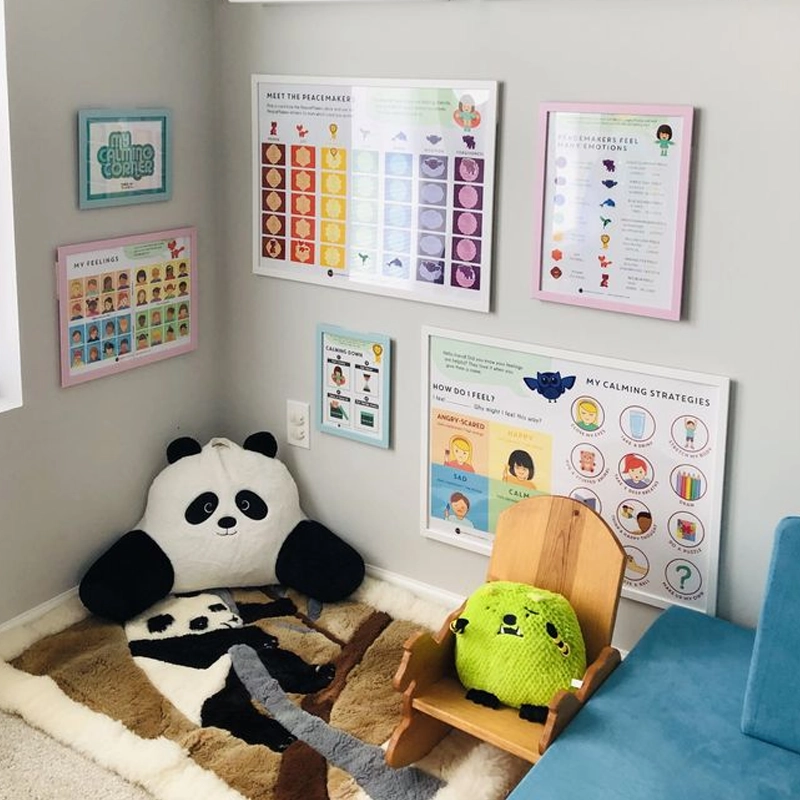
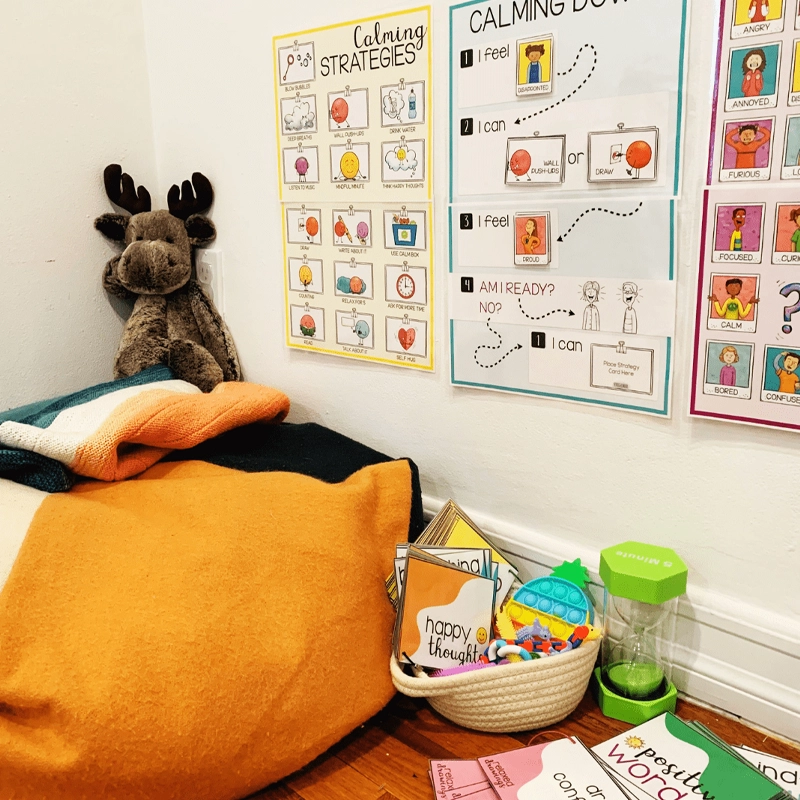
Preguntas frecuentes sobre los Rincones Calmantes
Los rincones de calma son herramientas versátiles, pero muchos padres, educadores y terapeutas a menudo se preguntan cómo usarlos eficazmente. Aquí encontrará respuestas a algunas de las preguntas más frecuentes sobre los rincones de calma.
¿En qué se diferencia un rincón de calma de un tiempo fuera?
Un rincón de tranquilidad y un tiempo de descanso sirven para propósitos muy diferentes.
- Rincón de la calma:
- Se centra en ayudar a los niños a autorregular sus emociones.
- Se proporcionan herramientas como botellas sensoriales, almohadillas con peso para el regazo y carteles de respiración para enseñar estrategias de calma.
- Enfatiza el crecimiento emocional y el refuerzo positivo.
- Se acabó el tiempo:
- A menudo se utiliza como método disciplinario para apartar a los niños de ciertas situaciones.
- Carece de herramientas u orientación para la regulación emocional, lo que hace que los niños se sientan aislados.
Si bien los tiempos de espera pueden abordar el comportamiento inmediato, los rincones de calma promueven la resiliencia emocional a largo plazo al enseñar a los niños cómo afrontar sus sentimientos de forma independiente.
¿Qué pasa si un niño se niega a utilizar el rincón de tranquilidad?
Es común que los niños se resistan a usar el rincón de la calma al principio, sobre todo si aún no entienden su propósito. Aquí te explicamos cómo animarlos:
- Modelar su usoMuestre a los niños cómo funciona la esquina usándola usted mismo. Por ejemplo, simule estar molesto y muestre cómo respirar profundamente o apriete una pelota antiestrés en la esquina.
- Involucre al niñoDeja que los niños ayuden a montar el rincón de la calma. Pueden elegir sus herramientas, adornos o pósteres favoritos, lo que fomenta el sentido de pertenencia.
- Ofrecer indicaciones suavesEn lugar de insistir, diga: “¿Te gustaría usar el rincón de la calma para sentirte mejor?” o “Veo que estás molesto; probemos juntos el rincón de la calma”.
- Utilice el refuerzo positivo:Elogie al niño cuando use el rincón, reforzándolo como un espacio seguro y positivo.
¿Qué elementos deben incluirse en un rincón de tranquilidad?
Los artículos de un rincón de la calma deben satisfacer las necesidades sensoriales y emocionales del niño. Estos son los elementos esenciales:
- Herramientas sensoriales:
- Pelotas antiestrés:Para estimulación táctil.
- Juguetes antiestrés:Para mantener las manos ocupadas y reducir la ansiedad.
- Auriculares con cancelación de ruido:Para bloquear sonidos abrumadores.
- Ayudas visuales:
- Carteles de respiraciónInstrucciones paso a paso para respiraciones calmantes.
- Gráficos de emociones:Ayude a los niños a identificar y expresar sus sentimientos.
- Artículos de confort:
- Mantas con peso o almohadillas para el regazo.
- Alfombras suaves o pufs para sentarse.
- Elementos interactivos:
- Diarios para que los niños mayores escriban sobre sus sentimientos.
- Botellas sensoriales para que los niños más pequeños se concentren en imágenes relajantes.
¿Cómo adaptar un rincón de tranquilidad a diferentes grupos de edad?
Los rincones relajantes se adaptan a niños pequeños, preescolares y de primaria:
- Para niños pequeños (1 a 3 años):
- Utilice herramientas simples y visualmente atractivas, como botellas sensoriales, animales de peluche y cuadros de emociones basados en imágenes.
- Mantenga el espacio pequeño y acogedor para evitar la sobreestimulación.
- Para niños en edad preescolar (3 a 5 años):
- Agregue herramientas estructuradas como carteles de respiración, juguetes antiestrés y relojes de arena.
- Incluya imágenes coloridas y guías fáciles de seguir para promover la independencia.
- Para estudiantes de primaria (6 a 10 años):
- Introduzca herramientas más interactivas, como diarios de reflexión emocional o rompecabezas relajantes.
- Cree un diseño más flexible con opciones de asientos multiusos y una decoración personalizable.
¿Son los rincones de tranquilidad adecuados para todos los niños?
Sí, los rincones de tranquilidad son adecuados para todos los niños, pero su diseño y uso deben adaptarse a las necesidades individuales:
- Niños con necesidades especiales:
- Incluya artículos sensorialmente amigables como juguetes texturizados, productos con peso y auriculares con cancelación de ruido para niños con autismo o TDAH.
- Simplifique las imágenes y asegúrese de que el espacio se sienta predecible y no abrumador.
- Niños ansiosos o altamente sensibles:
- Utilice una iluminación suave, música relajante y elementos reconfortantes como mantas o juguetes familiares para crear un ambiente seguro y acogedor.
- Niños activos o reacios:
- Ofrezca herramientas físicas como pelotas antiestrés o bandas de resistencia para canalizar su energía mientras se calma.
Un rincón de calma puede beneficiar a cualquier niño con los ajustes adecuados, ayudándolo a desarrollar resiliencia emocional y habilidades de autorregulación.
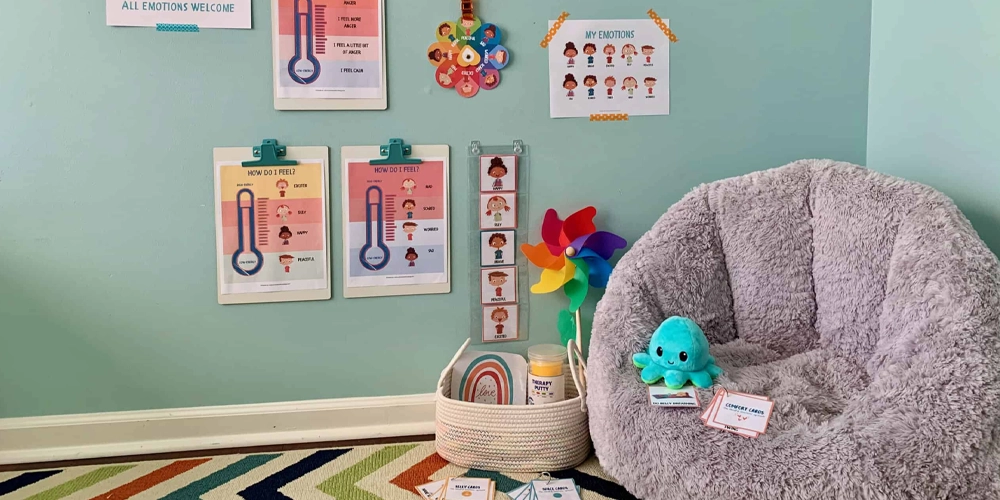
Un rincón de tranquilidad es más que un simple espacio físico: es un recurso vital que fomenta la resiliencia emocional, la autoconciencia y el bienestar mental de los niños. Ya sea en casa, en un aula preescolar o en un centro de terapia, estos espacios cuidadosamente diseñados brindan a los niños las herramientas para gestionar sus emociones y prosperar en situaciones difíciles.
Al incorporar herramientas sensoriales como almohadillas con peso para el regazo, juguetes antiestrés y carteles de respiración y adaptar el espacio a diferentes grupos de edad y necesidades, un rincón de calma se convierte en un santuario donde los niños pueden procesar sus sentimientos, recuperar la concentración y desarrollar habilidades esenciales de afrontamiento.
Con creatividad y una planificación minuciosa, los rincones de tranquilidad pueden transformar la forma en que los niños aprenden, crecen e interactúan con el mundo. Empieza a crear el tuyo hoy mismo y regala a tu hijo (o a tus alumnos) el regalo del empoderamiento emocional y un espacio seguro para descubrir su paz interior.

